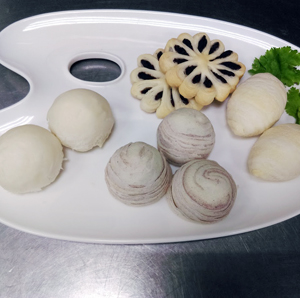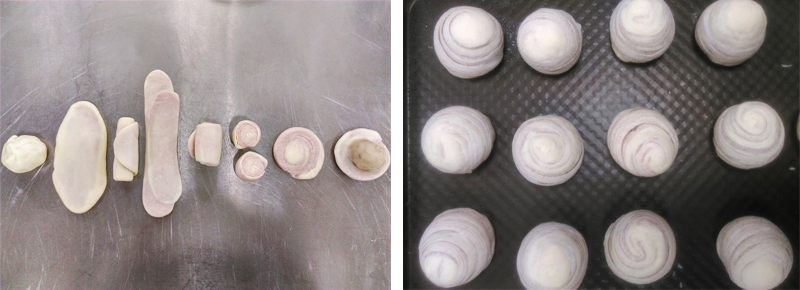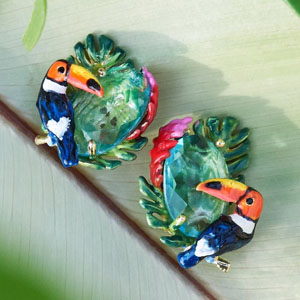06.2019 Life Guide
Ancient flavor and new eating way lead to 72 changes of the tradional pastry
Yu-Chang Technical Commercial Vocational High School / Wang Shuyi

Taiwan's traditional cake culture is extensive, profound and colorful. No matter the daily diet or festival sacrifices, you can see the shape of cake. In recent years, the public has played an innovative role in developing more and more flavors and styles. In this issue, "Gourmet Column" not only brings you to know the classification of traditional cakes, but also guides you to use a little ingenuity to match rolling, rolling, cutting and shaping to produce various delicious cakes.
Classification of Taiwan Cakes
I. Pastry crusts
Flour and syrup are used to make dough. Some of them add eggs, milk powder and grease to add flavor. Then they are wrapped in fillings to form various shapes. They are printed into different totems with cake molds. Most of them use the theme of welcoming happiness and auspiciousness, which has far-reaching implications and also adds beauty to cakes. Taiwan's ancient morning delicious cake belongs to this category, as well as Lu meat cake, Wudousha cake, jujube mud cake, Wuren cake, pineapple cake... And other products.
2. Oil Skin
Taichung City's famous Sun cakes belong to this category, and other products include mung beans, yolk pastry, sesame cake, wife's cake, garlic pastry, Xiangfei pastry and so on. And so on.
3. Crisps
Sugar-oil mixing method is used to mix all kinds of oils and fats with sugar, mix them into loose hair, add eggs, flour and other materials, mix them into crisp crust, then wrap them in various jam fillings, so that the outer crust and inner filling can reach the perfect proportion. Taiwan's most famous specialty "Pineapple Crisp" belongs to this category. Other variations include strawberry Crisp, blueberry Crisp and Hami Melon Crisp with various fruit flavors. And so on.
4. Cakes and pastries
Unlike the first three kinds of crusts, it is made of rice, such as mung bean cake, Salted Plum cake, sesame cake, etc. And so on.
In recent years, in order to meet the needs of the times, traditional cakes have been innovating continuously. They have more choices in appearance and taste. The changes include:
1. Adding various ingredients to the pastry filling
Modern people pay attention to health care, many cakes will be filled with nuts, such as walnuts, pine nuts, and other fats instead of lard, such as butter instead of traditional lard. Some fruit crisps add fruit grains and dried fruits, such as cranberries and plum preserves, to reduce the sweetness of cakes; others add salty food to sweet fillings to reduce sweetness and add flavor, such as pineapple crisp with salted egg yolk into Phoenix crisp, or sun cakes with garlic and seaweed flavors, which are modern. The display of human creativity.
2. Appearance Change of Cake Skin
The traditional filling method of oilskin products is to wrap in "dark crisp" or plastic, pinch out the shape, such as yolk crisp, Xiaoyue Niang, mung bean bun, curry dumpling, ox tongue cake, from the appearance can not see the inner filling; while taro crisp, tea pastry, rainbow crisp and other products, the filling method is to "bright crisp", through the oil. The color of crisp is changed by adding edible pigments or tea powder or purple potato powder, which shows the crisp outside and presents a beautiful spiral appearance. So far as the filling method of chrysanthemum crisp is "filling crisp", through the cutting and shaping after filling, the filling is exposed, so that the appearance is as beautiful as petals, and the inner filling is also clear at a glance.
3. Reduction of Cake Volume
Because modern people pay more attention to dietary health, the intake of sweets begins to decrease, and the family structure is dominated by small families, many traditional cakes have been reduced in size to meet the demand, such as the engagement cake, which weighed three kilograms and one kilogram in the early stage. At present, some stores have changed to twelve, and the volume of butter pastries has also been reduced to twelve. Cream pastries, moon cakes of various Mid-Autumn Festival are becoming more and more delicate.

DIY Classroom in this issue lets you try to achieve different appearance by changing different oils and crisps. The first one is to wrap the crust in the crisp, then roll it twice and directly wrap it in the filling to form a series of dark crisp products (e.g. mung beans). The other change is to use double quantity of crust crisp, through twice rolling, to split it into two parts by crosscutting or vertical cutting, to reveal the bright crisp series of the crust layer. Product (such as taro crisp, radish crisp); the last roll-wrapped filling method is the same as dark crisp, after cutting and shaping, reveal the filling, make filling crisp (such as chrysanthemum crisp).
[Materials]
Water and oil skin (12 grains):Medium gluten flour 129 grams, water 58 grams, lard 52 grams, fine sugar 13 grams
Crisp:Low gluten flour 80 grams, lard 40 grams
Filling:
1. Taro crisp (30 g/grain) needs 360 g taro filling.
2. Chrysanthemum crisp (30 g/grain) needs 360 g red bean stuffing.
3. The radish crisp (25 kg/grain) needs one white radish (about 1 kg), 15 kg shrimp skin and one onion. Shave white radish, add salt, dehydrate and drain, stir-fry shrimp skin with a little oil, mix dried radish shreds and scallions in a small fire, add salt, pepper and sesame oil to season, reserve, fry filling immediately, not long to put, so as not to let the radish out of water again.
[Practice]

2. Mix the pastry into a ball (no powder).
ThreeDark crisp (such as mung bean bun), filling crisp (such as chrysanthemum crisp) series, oil skin: crisp = 20 kg: 10 kg.
4. The dark crisp series is to wrap the water and oil skin in the crisp, press it back and forth from the middle, roll it up until it relaxes, press it again until it relaxes, roll it up until it relaxes, and finally roll the crust into a circle, wrap it directly in the filling, and close the mouth. The method of filling crisp series is to wrap the water and oil skin in the crisp, press it back and forth from the middle, roll it up until it relaxes, roll it up again until it relaxes, roll it up until it relaxes, and finally roll the crust into a circle, wrap it directly in the filling, close it, press the cake flat with the palm, the middle is not cut off, and the periphery is symmetrical. Cut 12 incisions, and then turn each incision in the same direction to reveal the filling, making petals, such as chrysanthemum.

6. Crushed crispy Taro crisp method: wrap twice the amount of water and oil skin into twice the amount of crisp (taro crisp needs 5 grams of purple potato powder or taro spices, when crushed, there will be layers of purple beautiful appearance). Roll the crisp Taro crisp forward and backward from the middle, roll it up until it relaxes, roll it up again until it relaxes, and finally roll it up until it relaxes. The pie skin is cut and rolled into a circular shape. The pie skin is cut upward and directly wrapped in the filling material. After closing and kneading, the pie skin can show the appearance of layers of threads.

8. Bake each product at 200 degrees above fire and 190 degrees below fire for 15-20 minutes to make the skin crisp and the bottom colored.
[Remarks]
1. Taro crisp can also be added to paste tea powder or other edible pigments to change into paste tea crisp and rainbow crisp.
2. The outer layer of the crispy crust is good-looking. When rolling the crispy crust, the layers will be like threads one by one.
3. The formula lard in the crisp can be changed into other oils (such as anhydrous butter).
4. If a variety of products are produced at a time, the amount of crust crisp can be doubled, then some of the crisps are taken out and mixed with purple potato flour for change.





















